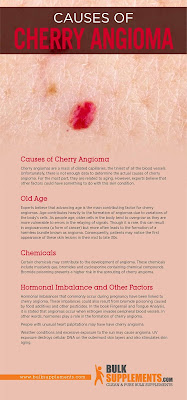Cherry angiomas, commonly referred to as Campbell de Morgan spots, are benign skin lesions that typically develop in middle to older age. They are caused by proliferating, dilated capillaries and postcapillary venules. They bear the name Campbell de Morgan in honour of an English surgeon.
Cherry angiomas, sometimes referred to as senile angiomas as well, are non-cancerous growths that start in the skin's capillary blood vessels. These tiny lesions can be bright red or deep purple in colour, and they typically range in size from a pinhead to roughly a quarter of an inch in diameter.
While cherry angiomas may sound like a strange fruit, they are actually a benign skin growth that many people get as they age. Though generally innocuous, these tiny red or purple spots can appear anywhere on the body and can cause concerns and worries. We'll delve into the topic of cherry angiomas in this blog, looking at their features,causes, and whether or not they require medical intervention.
Causes
The exact cause of cherry angiomas is still a mystery, but several factors may contribute to their development. Genetics may play a role, as they tend to run in families.Lesions, develop in relation to pregnancy and prolactinomas, suggesting the involvement of hormonal mediators exposure to certain chemicals, and prolonged sun exposure are also considered potential contributing factors.
The incidence of these lesions in people with diabetes, immunocompromised people, transplant recipients, and tropical climates has been found to be higher in recent studies.
Usual Appearance
Cherry angiomas are most known for their red or purple colour, which is
akin to a ripe cherry and thus gave rise to the term. They may appear as
smooth, elevated bumps on the skin and are usually round or oval in
shape
They appear as macules with a diameter of 1-3 mm that could eventually enlarge into papules, having a vivid cherry red colour, but it sometimes looks blue or purple. The good thing is that they never turn brown.
Cherry angiomas can occur in any age, but they are more common in adults, particularly in those over thirty. The risk of these skin growths increasing with age is observed in individuals.
Although these growths can develop practically anywhere on the body, the torso, arms, legs, and face are the most common places to find them.
Do You Need to Worry?
Cherry angiomas are generally benign and don't present any health risks, which is good news. Nonetheless, there are certain situations in which these growths may warrant further investigation:
It's best to see a dermatologist if a cherry angioma changes in size, colour, or shape unexpectedly. Although uncommon, these alterations might point to a more serious skin disease.
It's best to consult a doctor if a cherry angioma starts to bleed, itchy, or cause discomfort. These signs may point to a problem that needs to be addressed.
What Happens Next?
These lesions are thought to be completely harmless, but your skin doctor should be your next port of call if th you are worried about their existence.
Cherry angiomas are typically diagnosed visually by a medical professional, most frequently a dermatologist.
Dermoscopy entails a closer look at the skin using a portable instrument called a dermatoscope. This can assist medical professionals in differentiating between various skin lesions, such as cherry angiomas.
 |
| Dermoscopy |
Dermatologists occasionally advise a biopsy in order to confirm the diagnosis. A microscopic examination of a small sample of tissue removed from the angioma can help rule out any abnormal or malignant characteristics.
Although blood tests are not commonly utilised for the diagnosis of cherry angiomas, your healthcare provider may request blood tests if additional skin conditions or underlying health issues are suspected.
Rarely, blood vessels and other structures beneath the skin may be assessed using imaging tests like ultrasonography.
Do You Need Treatment??
 |
| Freezing Therapy |
In this scenario, your healthcare provider would probably reassure you. Since cherry angiomas are usually benign, the majority of people with them decide not to get treatment. However, there are a number of treatment options available if a person finds them unsightly or if a growth starts to cause problems. These could involve electrocautery, sclerosing therapy, cryotherapy, or laser therapy, depending on the angioma's location and size.
 |
| Reassurance |
Remember that although these tiny red spots may seem like a bizarre addition to your skin, they are frequently just a normal aspect of ageing.The only times lesions become problematic are when they recur frequently, keep getting bigger, or cause the patient to worry about their appearance.
 |
| Laser Therapy |







No comments:
Post a Comment